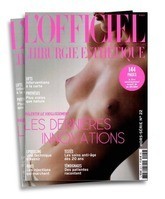Media Publication
I want a natural nose
I want a natural-looking nose
Article from ”L’officiel chirurgie esthétique”
Respect the harmony, the unique personality of a face and the natural anatomy, commit to embellishingthe nose withless invasive products and techniques, this isDr. Raspaldo’snew concept of rhinoplasty. By Paule Cornille.
1.WHO IS THIS FOR?
For women who prefer anatural-looking nose, as well assimple and soft techniques that take physiology into consideration.
2. BEFORE THE PROCEDURE
Just as any other rhinoplasty, this procedure requires two consultations, as well as a complete blood test. Then, you will have to wait for at least 15 days, a mandatory waiting period because you might want to think your decision over. After a complete analysis of the nose and the tissues, the surgeon takes photos with front views, profile and three-quarter views. He will then use the morphing technique to simulate the different reshaping possibilities, that you will be able toseeon a screen.
3. THE SURGERYPROTOCOL
The procedure is performed under general anesthesia only if the nasal septumis concerned, otherwise a neuroleptenalgesia will be enough. “It is almost always an outpatient procedure,” says Dr. Herve Raspaldo. To reshape the nose, mask hollow areas or deformities, heuses cartilage harvested from the patient herself (himself) rather than synthetic products (silicone, goretex, coral) – he will not inject synthetic products either. Instead of using the classic occlusive splints made out of plaster, he prefers thermoformable models, whichare well ventilated, more solid and easier to reshape. And to keep them in place, he chose a biocompatible surgical varnish rather than using plasters,which are often allergenic. Also, when it comes to fixing the cartilage or the mucous membrane in the nose, heuses a biological glue, preventing any inflammatory reaction.
4. POST–OPERATIVECARE
The recovery time is shorter than with conventional rhinoplasty. In 80% of cases, edema and bruising disappear after eight days. Their resorption can be accelerated by cryotherapy sessions – a gas at 70° C is sprayed all over the face for a few days. The splints are removed after six days. The old nasal packings that cause so much discomfort are now replaced by painless,resorbable pads. They prevent bleeding, but allow patients to breathe almost normally and can be removed after 12 to 24 hours. Thanks to the less invasive instruments and technique, this rhinoplasty is almost painless.
5. AFTER THE PROCEDURE
The patient will be advised to sleep on the side or on the back for a while and torefrain from sports or any physical activity for at least a week.
6. SCARS
They will be invisible,because all sutures – made with absorbable threads – are located inside the nose.
7. RESULTS
The final result is usually visible after one week, but it continues to refine for several months.
8. RISKS
They are kept to a minimum: the cartilage, muscles and mucous membranes will be protected and respected.In addition, thanks to the prior morphing, there is no risk of having a dramatical change in your face or not having the expected result. However, small imperfections can appear, but they can be corrected after 3months to one year.
DOCTOR HERVÉ RASPALDO’S OPINION
“I have been practicing aesthetic rhinoplasty since 1986 and my long experience allowed me to develop this”new way of conceiving the nose”. The “Rhino-bio” is inspired by the general organic trend, starting with bio-ethics. This approach involves guiding the patient towards the nose shape that will best suit him or her, refusing a surgery that is considered unsuited, providing the best analyzeand understanding by usinga morphing software that shows the expected results. It also involvestaking biodiversity into account – reshaping different noses adapted to the patient’s personality but also his or her racial origins.
This is also about biotechnology and biocompatibility: we only use natural materials that are not likely to be traumatic or harmful in ashort or long term. Rather than introducing foreign components, westrive to keep as much original cartilage as possible,by refining orreshaping it as needed. In a word, it’s an innovative process, totally adapted to the latest evolutions in our society.”


